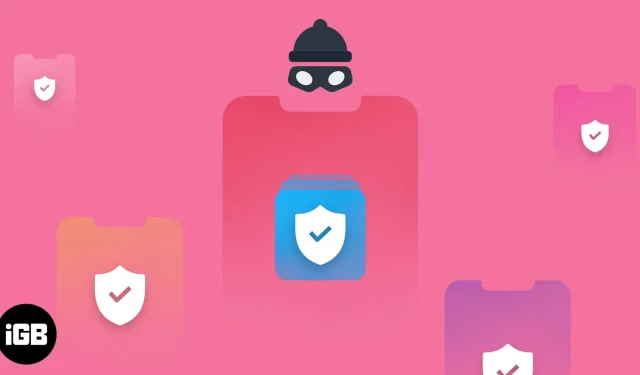How to protect iPhone data from thieves

Our iPhones contain valuable personal information such as contacts, messages, photos, as well as sensitive data such as bank account details and passwords. So, what if iPhone data is stolen? Thieves and hackers are always looking for ways to gain unauthorized access to devices and data. Therefore, taking the necessary steps to protect your iPhone data from thieves is critical.
In this guide, I will share practical tips and methods to protect your iPhone and its contents from prying eyes. Whether you’re at home or on the go, knowing how to protect your iPhone data from thieves will help you keep everything safe and give you peace of mind.
What happens if your iPhone is stolen?
If your iPhone falls into the wrong hands after being stolen, there are several potential threats.
- Financial theft: Thieves can use sensitive personal information such as credit card details, bank account information, or passwords to steal identity or financial fraud.
- Access to personal data. If you have personal photos, messages, or documents on your iPhone, they may use that information maliciously.
- Unauthorized access to accounts. Saved iCloud Keychain login credentials provide unauthorized access to your online accounts.
- Device Misuse: Your iPhone can be used to make calls, send messages, or access the Internet, resulting in unauthorized charges.
- Compromised security: If you don’t use a screen lock password or Face ID, it exposes your data, compromising security.
- Blackmail or extortion: Thieves can use personal data on your iPhone to blackmail or extort services from you.
Also, if the thief knows your iPhone’s passcode, they can change your Apple ID password, remove your trusted accounts or mobile number, and most importantly, disable the Find My connection. Thus, you cannot delete your data remotely and lose access to your iCloud account. What’s more, they get access to use Apple Pay or send Apple Cash.
These are just some of the potential data threats that can arise if your iPhone is stolen. It is extremely important to take immediate steps to protect your iPhone and data to minimize the risk of these threats.
What should you do first to protect your iPhone data?
I know this is a very panicky situation, but you must act quickly to prevent data leakage. I would suggest checking out our article on how to take drastic action after your iPhone is stolen.
Also, I highly recommend turning off Apple Pay remotely. In this way, you can minimize the risk of data leakage and prevent thieves from gaining access to your personal information. Once you have read this data, you should take the following precautions to keep your iPhone safe in case of theft.
5 Tips to Protect Your iPhone Data from Thieves
Standard security protocols are easy to hack, and basic iPhone features can help criminals steal your entire digital life. So while you can’t always prevent your device from being stolen, you should take precautions to protect your iPhone from theft and reduce the ease with which criminals can access your data.
1. Use an alphanumeric passcode on iPhone
If you think that Face ID is the best data protection shield, then it is not. When your iPhone restarts, it asks for a passcode instead of Face or Touch ID. Plus, anyone can access the iCloud Keychain password manager, approve Apple Pay, or authenticate anything with a passcode.
So don’t stick to your six-digit numeric password. Use longer, more complex alphanumeric passcodes that are harder to crack. You can easily set up an alphanumeric passcode on your iPhone. Also, change the auto-lock to 30 seconds in the display and brightness settings. This ensures that your phone will never be left unlocked for an extended period of time.
2. Don’t enter passwords in public
It may sound creepy, but the thief may be stalking you. And if they know your password, they can steal your device.
Law enforcement officials claim that criminals are devising tricky methods to get people’s access codes, including taking pictures of them from a distance. Therefore, when in public, cover your screen. Also, use Face ID or Touch ID to avoid tracking your passcode when you’re not at home.
3. Add passwords to iPhone apps
You can add different access codes to apps like Venmo, PayPal, etc., or block apps with sensitive data. Do not use the same LockScreen password for any other accounts. Also, I suggest setting up a Screen Time passcode. Also, select Don’t Allow under Account Changes.
4. Don’t rely solely on iCloud Keychain
As discussed, if a thief knows your password, he can access all of your saved passwords from iCloud Keychain. This allows scammers to access bank accounts on stolen iPhones. Therefore, you must change all confidential passwords.
For added security, use password manager apps that support biometric authentication but require a master password if unsuccessful.
5. Never store sensitive information as photos
If you ever need to scan important documents with sensitive information such as passports, licenses, cards, SSNs, etc., delete them from Photos immediately after use. Instead, store them in a password manager’s secure file storage. It helps a lot to protect your iPhone data from thieves.
Stay safe!
You must protect your iPhone data from thieves as it contains a lot of personal and sensitive information. Apart from the tips mentioned above, avoid public Wi-Fi networks and use two-factor authentication to protect your iPhone from hackers. Always be vigilant and remember the safety of your iPhone and its contents.
Leave a Reply